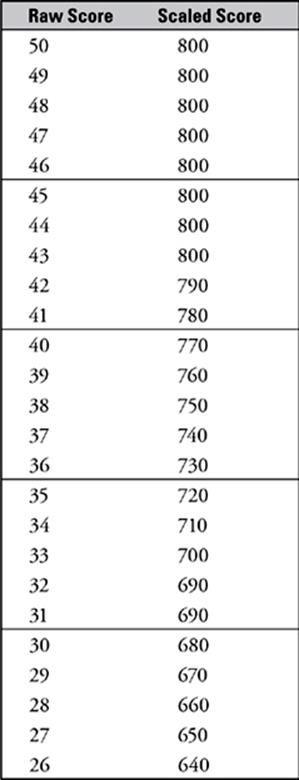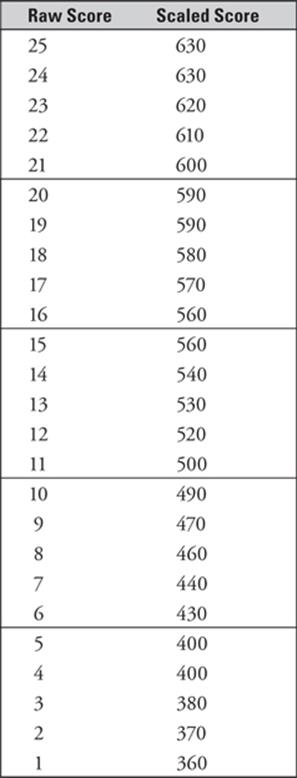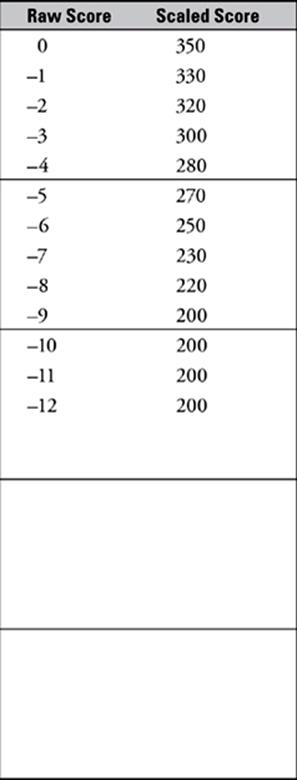SAT Math 1 & 2 Subject Tests
Chapter 15
Mathematics Level 2 Practice Test Form A
Click here to download a PDF of the Mathematics Level 2 Practice Test Form A.
![]()
MATHEMATICS LEVEL 2 TEST FORM A
For each of the following problems, decide which is the BEST of the choices given. If the exact numerical value is not one of the choices, select the choice that best approximates this value. Then fill in the corresponding oval on the answer sheet.
Notes: (1) A scientific or graphing calculator will be necessary for answering some (but not all) of the questions on this test. For each question, you will have to decide whether or not you should use a calculator.
(2) For some questions in this test you may have to decide whether your calculator should be in the radian mode or the degree mode.
(3) Figures that accompany problems on this test are intended to provide information useful in solving the problems. They are drawn as accurately as possible EXCEPT when it is stated in a specific problem that its figure is not drawn to scale. All figures lie in a plane unless otherwise indicated.
(4) Unless otherwise specified, the domain of any function f is assumed to be the set of all real numbers x for which f(x) is a real number. The range of f is assumed to be the set of all real numbers f(x), where x is in the domain of f.
(5) Reference information that may be useful in answering the questions on this test can be found below.
THE FOLLOWING INFORMATION IS FOR YOUR REFERENCE IN ANSWERING SOME OF THE QUESTIONS ON THIS TEST.
Volume of a right circular cone with radius r and height h: V = ![]() πr2 h
πr2 h
Lateral area of a right circular cone with circumference of the base c and slant height ℓ: S = ![]() cl
cl
Volume of a sphere with radius r: V = ![]() πr3
πr3
Surface area of a sphere with radius r: S = 4πr2
Volume of a pyramid with base area B and height h: V = ![]() Bh
Bh
1. If r − s > r + s, then which of the following must be true?
(A) r > s
(B) s < 0
(C) r < 0
(D) r < s
(E) s > 0
2. If f(x) =|x| + 10, for which of the following values of x does f(x) = f(−x) ?
(A) −10 only
(B) −10 and 10 only
(C) All real x
(D) All real x except 10
(E) All real x except −10 and 10
3. 
(A) 0
(B) 0.58
(C) 1
(D) 105
(E) 210
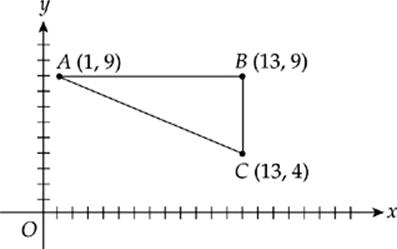
Figure 1
4. In Figure 1, sin ∠BAC =
(A) ![]()
(B) ![]()
(C) ![]()
(D) ![]()
(E) ![]()
5. Which of the following is the complete solution set of the system:
A = {(x, y): x2 + y2 = 25} and
B = {(x, y): y = x + 1}?
(A) {(5, 5)}
(B) {(16, 9)}
(C) {(−4, −3)}
(D) {(−4, −3), (3, 4)}
(E) {(−3, −4), (4, 3)}
6. If jk ≠ 0, then  =
=
(A) k2 − ![]()
(B) j2 − ![]()
(C) jk − 1
(D) j2 − 1
(E) k2 − 1
7. All of the following can be formed by the intersection of a cube and a plane EXCEPT
(A) a triangle
(B) a point
(C) a rectangle
(D) a line segment
(E) a circle
8. If f(x) = ![]() and g(x) =
and g(x) = ![]()
![]() + 1, then f(g(2.3)) =
+ 1, then f(g(2.3)) =
(A) 0.1
(B) 1.2
(C) 1.3
(D) 1.8
(E) 2.3
9. If x mod y is the remainder when x is divided by y, then (61 mod 7) − (5 mod 5) =
(A) 2
(B) 3
(C) 4
(D) 5
(E) 6
10. Which of the following must be true?
I. sin(−θ) = −sin θ
II. cos(−θ) = −cos θ
III. tan(−θ) = −tan θ, where tan θ is defined
(A) I only
(B) II only
(C) III only
(D) I and III only
(E) I, II, and III
11. If for all real numbers x, a function f(x) is defined by f(x) = ![]() , then f(15) − f(14) =
, then f(15) − f(14) =
(A) −2
(B) 0
(C) 1
(D) 2
(E) 4
12. If ![]() = 25, then x =
= 25, then x =
(A) 1.00
(B) 1.90
(C) 2.19
(D) 3.62
(E) 5.00
13. If the ratio of sec x to csc x is 1 : 4, then the ratio of tan x to cot x is
(A) 1 : 16
(B) 1 : 4
(C) 1 : 1
(D) 4 : 1
(E) 16 : 1
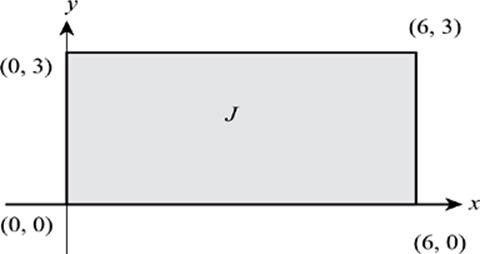
Figure 2
14. In Figure 2, rectangle J contains all points (x, y). What is the area of a rectangle that contains all points (2x, y − 1) ?
(A) 12
(B) 18
(C) 24
(D) 36
(E) 48
15. In right triangle ABC, ∠B measures 90°, ∠C measures 27°, and AB = 9. What is the length of the hypotenuse of ∆ABC ?
(A) 4.1
(B) 10.1
(C) 17.7
(D) 19.8
(E) 21.2
16. Which of the following is a zero of f(x) = x2 + 6x − 12 ?
(A) −15.16
(B) −7.58
(C) 0.67
(D) 3.16
(E) 7.58
17. If sin x = m and 0 < x < 90°, then tan x =
(A) ![]()
(B) ![]()
(C) ![]()
(D) ![]()
(E) 
18. If logy 2 = 8, then y =
(A) 0.25
(B) 1.04
(C) 1.09
(D) 2.83
(E) 3.00
19. If sinθ = ![]() and −
and − ![]() ≤ θ ≤
≤ θ ≤ ![]() , then cos(2θ) =
, then cos(2θ) =
(A) −![]()
(B) −![]()
(C) ![]()
(D) ![]()
(E) 1
20. If f(x) = ![]() − 1, for all x > 0, then f−1(x)
− 1, for all x > 0, then f−1(x)
(A) (x + 1)2
(B) x2 + 2
(C) x2 + 1
(D) (x − 1)2
(E) (x + 2)2
21. When 4x2 + 6x + L is divided by x + 1, the remainder is 2. Which of the following is the value of L ?
(A) 4
(B) 6
(C) 10
(D) 12
(E) 15
22. What is the length of the major axis of the ellipse given by the equation  = 1 ?
= 1 ?
(A) 3.2
(B) 4.5
(C) 8.9
(D) 10.0
(E) 20.0
23. If f(x) = [x], where [x] is the greatest integer less than or equal to x, which of the following is a graph of f![]() − 1 ?
− 1 ?
(A) 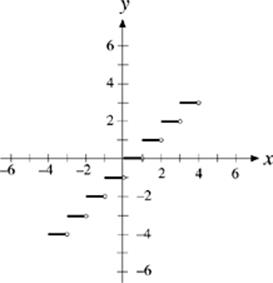
(B) 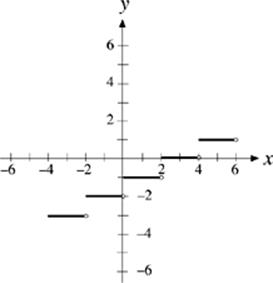
(C) 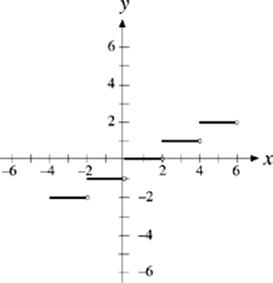
(D) 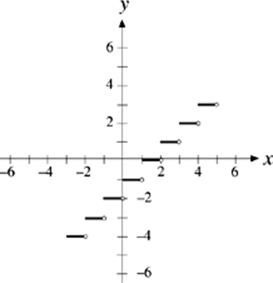
(E) 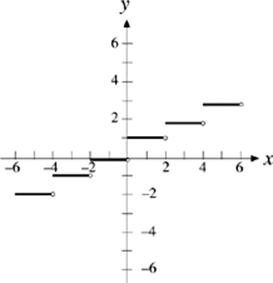
24. Which of the following is equal to the positive value of sec(cos−1(0.3527)) ?
(A) 0.01
(B) 0.94
(C) 1.69
(D) 2.84
(E) 69.35
25. If f(x) = x2 + 5x + 6, for what value of x will f(x) have its minimum value?
(A) −3
(B) −![]()
(C) −2
(D) 0
(E) ![]()
26. If the 20th term of an arithmetic sequence is 20 and the 50th term is 100, what is the first term of the sequence?
(A) −33.33
(B) −30.67
(C) 1.00
(D) 2.00
(E) 2.67
27. The polar equation r sin θ = 1 defines the graph of
(A) a line
(B) a circle
(C) an ellipse
(D) a parabola
(E) a hyperbola
28. For which of the following functions f is f −1 a function?
I. f(x) = x2
II. f(x) = x3
III. f(x) = |x|
(A) I only
(B) II only
(C) I and III only
(D) II and III only
(E) I, II, and III
29. What is  ?
?
(A) −2
(B) −1
(C) 1
(D) 2
(E) The limit does not exist.
30. If f(x) =  , and g(f(x)) = x, then g(x) =
, and g(f(x)) = x, then g(x) =
(A) 
(B) 
(C) 
(D) 7 ln(2x −)
(E) 
31. A cube is inscribed in a sphere of radius 6. What is the volume of the cube?
(A) 36![]()
(B) 36π
(C) 216
(D) 192![]()
(E) 216![]()
32. A right circular cone has height h and radius r. If the cone is cut into two pieces by a plane that passes through the midpoint of the height and is parallel to the base, then the volume of the larger of the two resulting solids is
(A) ![]()
(B) ![]()
(C) ![]()
(D) 
(E) 
33. If ex ≠ 1 and ![]() =
= ![]() , then x =
, then x =
(A) −1.73
(B) −0.55
(C) 1.00
(D) 1.10
(E) 1.73
34. If the graph of the equation y = 2x2 − 6x + c is tangent to the x-axis, then the value of c is
(A) 3
(B) 3.5
(C) 4
(D) 4.5
(E) 5
35. If x = i − 1, then x2 + 2x + 2 =
(A) 2i + 4
(B) 4 + 2i
(C) 0
(D) i
(E) −2
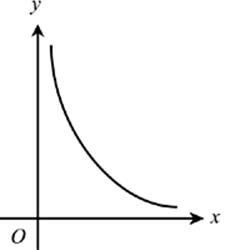
Figure 3
36. The curve shown in Figure 3 could represent a portion of the graph of which of the following functions?
(A) y = ex
(B) y = e−x
(C) y = 100 − x
(D) y = x2 − 3x + 2
(E) xy = 3
37. If two coins are removed at random from a purse containing three nickels and eight dimes, what is the probability that both coins will be dimes?
(A) ![]()
(B) ![]()
(C) ![]()
(D) ![]()
(E) ![]()
38. A function g(x) is odd if g(−x) = −g(x) for all x and even if g(x) = g(−x) for all x. Which of the following is the graph of a function that is both odd and even?
(A) 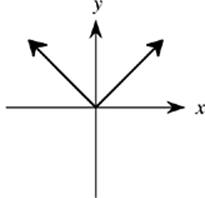
(B) 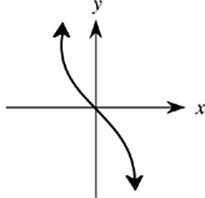
(C) 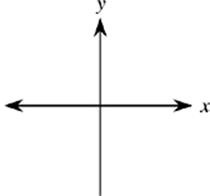
(D) 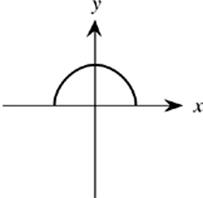
(E) 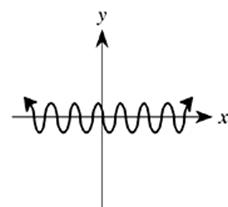
39. Points A and B lie on the edge of a circle with center O. If the circle has a radius of 5, and if the measure of ∠AOB is 70°, what is the length of chord AB ?
(A) 2.9
(B) 4.7
(C) 5.0
(D) 5.7
(E) 9.4
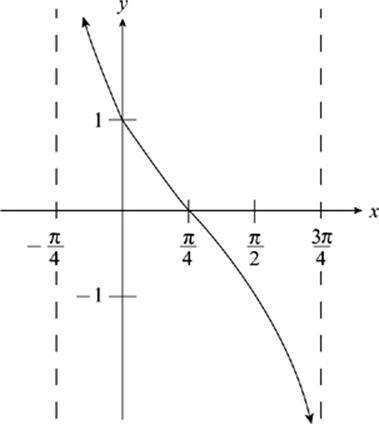
Figure 4
40. If the graph of y = f(x) is shown in Figure 4, then which of the following could be true?
(A) f(x) = tan
(B) f(x) = cot
(C) f(x) = tan
(D) f(x) = cot
(E) f(x) = tan
41. Vectors v and w have components (−3, 4) and (12, 5), respectively. If z = −(v + w), then z has components
(A) (−9, −9)
(B) (5, 13)
(C) (−5, 13)
(D) (9, 9)
(E) (![]() ,
, ![]() )
)
42. If f(x) =  , then for which of the following values of x does f(x) = 0.33 ?
, then for which of the following values of x does f(x) = 0.33 ?
(A) 0.62
(B) 0.71
(C) 1.36
(D) 3.93
(E) 4.95
43. The system of equations given by
2x + 3y = 7
10x + cy = 3
has solutions for all values of c EXCEPT
(A) −15
(B) −3
(C) 3
(D) 10
(E) 15
44. If f(x, y) = ![]() for all x, y, f(a, b) = 15, f(b, c) = 20, and f(a, c) = 10, which of the following could be the product of a, b, and c ?
for all x, y, f(a, b) = 15, f(b, c) = 20, and f(a, c) = 10, which of the following could be the product of a, b, and c ?
(A) 18.26
(B) 54.77
(C) 284.60
(D) 1,800.00
(E) 3,000.00
45. If x > 0 and y > 1, then logx2 y =
I. logx y2
II. logx ![]()
III. logx![]()
(A) I only
(B) II only
(C) III only
(D) I and II only
(E) II and III only
46. Carlos is filling a spherical balloon with water. If he increases the volume of the balloon from 4,188.79 cubic centimeters to 14,137.167 cubic centimeters in 12 seconds, then what is the average rate at which he has increased the balloon”s surface area?
(A) 130.9 square centimeters per second
(B) 314.159 square centimeters per second
(C) 829.031 square centimeters per second
(D) 1,570.796 square centimeters per second
(E) 9,948.377 square centimeters per second
47. What is the value of |6 − 3i| ?
(A) −3
(B) 3![]()
(C) 3![]()
(D) 9
(E) 15
48. The menu of a certain restaurant lists 10 items in column A and 20 items in column B. A family plans to share 5 items from column A and 5 items from column B. If none of the items are found in both columns, then how many different combinations of items could the family choose?
(A) 25
(B) 200
(C) 3,425
(D) 3,907,008
(E) 5.63 × 1010
49. y varies directly as the square of x. When y = 2.5, x = 0.5. If y = 80, then x could equal
(A) −2![]()
(B) −8
(C) −10
(D) −16
(E) −64
50. Seven blue marbles and six red marbles are held in a single container. Marbles are randomly selected one at a time and not returned to the container. If the first two marbles selected are blue, what is the probability that at least two red marbles will be chosen in the next three selections?
(A) ![]()
(B) ![]()
(C) ![]()
(D) ![]()
(E) ![]()
S T O P
IF YOU FINISH BEFORE TIME IS CALLED, YOU MAY CHECK YOUR WORK ON THIS TEST ONLY. DO NOT WORK ON ANY OTHER TEST IN THIS BOOK.
HOW TO SCORE THE PRINCETON REVIEW PRACTICE SAT MATH SUBJECT TEST
When you take the real exam, the proctors will collect your test booklet and bubble sheet and send your bubble sheet to New Jersey where a computer looks at the pattern of filled-in ovals on your bubble sheet and gives you a score. We couldn”t include even a small computer with this book, so we are providing this more primitive way of scoring your exam.
Determining Your Score
STEP 1 Using the answers on the next page, determine how many questions you got right and how many you got wrong on the test. Remember: Questions that you do not answer don”t count as either right answers or wrong answers.
STEP 2 List the number of right answers here.
STEP 3 List the number of wrong answers here. Now divide that number by 4. (Use a calculator if you”re feeling particularly lazy.)
STEP 4 Subtract the number of wrong answers divided by 4 from the number of correct answers. Round this score to the nearest whole number. This is your raw score.
STEP 5 To determine your real score, take the number from Step 4 above and look it up in the left column of the Score Conversion Table on this page; the corresponding score on the right is your score on the exam.
(A) ______________
(B) ______________ ÷ 4 = (C)______________
(A) ______________ − (C) ______________ = ______________
MATHEMATICS LEVEL 2 SUBJECT TEST FORM A
Answer Key
1. B
2. C
3. D
4. A
5. D
6. E
7. E
8. B
9. D
10. D
11. B
12. D
13. A
14. D
15. D
16. B
17. B
18. C
19. D
20. A
21. A
22. C
23. B
24. D
25. B
26. B
27. A
28. B
29. D
30. A
31. D
32. E
33. B
34. D
35. C
36. E
37. C
38. C
39. D
40. D
41. A
42. A
43. E
44. C
45. B
46. A
47. C
48. D
49. A
50. D
MATHEMATICS LEVEL 2 SUBJECT TEST SCORE CONVERSION TABLE
